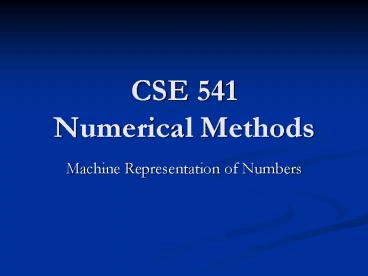CSE 541 Numerical Methods - PowerPoint PPT Presentation
1 / 15
Title:
CSE 541 Numerical Methods
Description:
If value after last retained digit is 5, then truncate. If value after last digit is =5, then: ... are not zero, round-up. Else, randomly round-up or truncate. ... – PowerPoint PPT presentation
Number of Views:32
Avg rating:3.0/5.0
Title: CSE 541 Numerical Methods
1
CSE 541Numerical Methods
- Machine Representation of Numbers
2
Speed
- The computer vs the human
- Who can count to 1 trillion the fastest?
- Human count from one to 1,000,000,000,000 by one
- - or -
- Computer Execute on a Pentium-4 2GHz machine
- int i 1
- while (1)
- printf( d/n, i )
- Computers are extremely fast at performing simple
arithmetic
3
Blazing Fast
- Assume a human can count on average one number
per second (bad assumption). - Implies 1 trillion seconds, or about 32,000
years!!!! - Assume that a 2GHz machine can increment by one
each clock cycle. - Implies 500 seconds!!!!
4
Machine Precision
- What is our current National Debt?
- (see http//www.brillig.com/debt_clock/)
- What is the annual revenue of a Fortune 100
company? - How many molecules are in one mole of gas (under
ideal assumptions) - How many pixels are displayed in a two hour HDTV
movie? - What is the current balance of Bill Gates
checking account? - How many ounces of Pepsi are consumed per year?
- What is the smallest measurable mass in the
universe that is not zero?
5
Machine Precision
- Problem
- We live in a world with a wide range of scales
- Computers have limited capabilities
6
Machine Precision
- Computers have limited capabilities!!!
7
Accuracy and Range
- More bits you have to represent numbers means
- A wider range and more accuracy
- Integer Representation
- 16-bit integers (common in the late 1990s)
- 216 65,536
- 32-bit integers
- 232 4,294,967,296
- 64-bit integers
- 264 ? 1.84 1019
ltlt 1,000,000,000,000
Still no Avagadros number 6.022 1023
8
Back to Our Challenge
- A 2GHZ 32-bit machine may be blazing fast, but it
will never reach one trillion either, if care
isnt taken!!! - Overflow
- Computer Forever
- Human 32,000 years
- Forever gtgt 32,000 years, humans win!!!!
9
Accuracy and Standards
- What is int i and what is its range?
- Machine dependent
- ANSI C standard
- int machine dependent
- short machine dependent
Not much of a standard, huh?
10
Advice
- Use the preprocessor to define your own types
- define CSEint int \\ I want this to be 32-bit
signed integer - define CSEshort short \\ 16-bit signed integer
- Hence, if you port to another architecture and
need to change it, only change it in one place. - Likewise, use each packages types glFloat,
11
Numbers
- Whole numbers 0,1,2,
- Signed integers ,-1,0,1,2,
- Rational numbers a/b, 1/3, etc.
- Irrational numbers v2, e, pi, etc.
- Is there a difference between 0.1 and 1/3?
12
Representing Real Numbers
- In Base-10, we can express any number as a sum of
weighted powers of ten. - Hence
13
Representing Real Numbers
- In Base-2 or binary we have a series in powers of
two?
14
Limiting Precision
- Truncate PI
- Truncate to what?
- To 8 significant digits
- Okay
- 3.1415926535897932384626433832795
- ?
- 3.1415926
15
Truncation vs Rounding
- Round to nearest value
- 3.1415926535897932384626433832795
- ?
- 3.1415927
- Rules
- If value after last retained digit is gt 5, then
round-up. - If value after last retained digit is lt 5, then
truncate. - If value after last digit is 5, then
- If all remaining digits are not zero, round-up.
- Else, randomly round-up or truncate.































